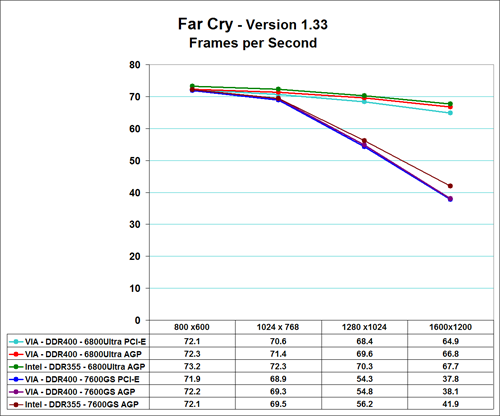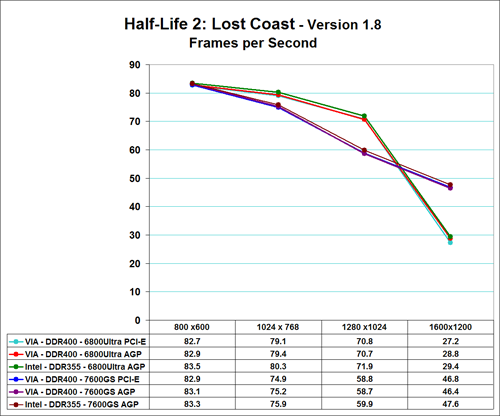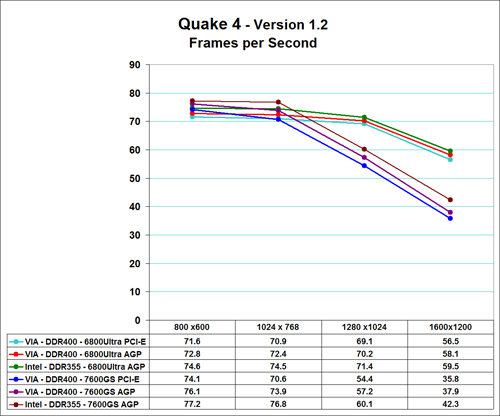ASRock Core 2 Duo: AGP/PCI Express Graphics Performance, Part Tres
by Gary Key on August 15, 2006 6:30 AM EST- Posted in
- Motherboards
Graphics Performance Comparison
While our previous articles concentrated on memory performance, today's article solely consists of gaming benchmarks and the synthetic 3DMark tests from Futuremark. The 3DMark series of benchmarks developed and provided by FutureMark are among the most widely used tools for benchmark reporting and comparisons. Although the benchmarks are very useful for providing consistent comparisons across a broad array of GPU and CPU configurations they are not a substitute for actual application and gaming benchmarks. In this sense we consider the 3DMark benchmarks to be purely synthetic in nature.
The gap between PCI-E and AGP solutions is less than 2% with both video card choices. Our first tests show AGP performing slightly better than PCI-E on the VIA platform with the Intel platform performing better overall. The 6800 Ultra series outperforms the 7600GS up to 38% in 3DMark05 and 26% in 3DMark06. Let's see if these differences carry over into our game benchmarks.
We utilized Far Cry, Half Life 2 and Quake 4 in our memory test articles because they are sensitive to memory changes and potentially bus throughput issues in our comparison. We added Prey and Serious Sam 2 to our benchmark mix because they are typically very GPU dependent and scale well. We originally tested at both 1024x768 and 1280x1024 resolutions at High Quality settings without anti-aliasing or antistrophic filtering enabled. We have also added 800x600 and 1600x1200 resolutions with the same settings.
Our three memory sensitive games show a consistent pattern with the AGP capability of the ASRock 775Dual-VSTA performing up to 5% higher than the PCI-E version in our testing. Overall, the AGP slot performance is better than the PCI Express slot even in 800x600 testing where the X4 operation handicap should not make a difference. The Intel 865 chipset offers better AGP performance especially as the resolutions start to scale upward. Looking at the gaming results from our previous article, the X16 PCI-E solutions typically offer equal or better performance than the AGP offerings. Whether it's the extra bandwidth or simply a less-than-perfect PCI-E implementation on the 775Dual-VSTA we can't say without further testing. However, the bottom line is that AGP performance is better than PCI-E performance on this particular motherboard.
The 6800 Ultra is still a very competitive card when compared to the 7600GS in these particular benchmarks, although it stumbles at 1600x1200 in Half Life 2- Lost Coast. The ATI X850XT-PE would score in a similar fashion if not better than the 6800 Ultra, though of course it lacks SM3.0 support which can be useful in more recent titles. Those owners with a graphics card in this class can still get by with most of today's games. We will have Oblivion results in our final article although we highly suggest going with a different solution to play this game at decent settings
While our previous articles concentrated on memory performance, today's article solely consists of gaming benchmarks and the synthetic 3DMark tests from Futuremark. The 3DMark series of benchmarks developed and provided by FutureMark are among the most widely used tools for benchmark reporting and comparisons. Although the benchmarks are very useful for providing consistent comparisons across a broad array of GPU and CPU configurations they are not a substitute for actual application and gaming benchmarks. In this sense we consider the 3DMark benchmarks to be purely synthetic in nature.
 |
| Click to enlarge |
The gap between PCI-E and AGP solutions is less than 2% with both video card choices. Our first tests show AGP performing slightly better than PCI-E on the VIA platform with the Intel platform performing better overall. The 6800 Ultra series outperforms the 7600GS up to 38% in 3DMark05 and 26% in 3DMark06. Let's see if these differences carry over into our game benchmarks.
We utilized Far Cry, Half Life 2 and Quake 4 in our memory test articles because they are sensitive to memory changes and potentially bus throughput issues in our comparison. We added Prey and Serious Sam 2 to our benchmark mix because they are typically very GPU dependent and scale well. We originally tested at both 1024x768 and 1280x1024 resolutions at High Quality settings without anti-aliasing or antistrophic filtering enabled. We have also added 800x600 and 1600x1200 resolutions with the same settings.
 |
 |
 |
| Click to enlarge |
Our three memory sensitive games show a consistent pattern with the AGP capability of the ASRock 775Dual-VSTA performing up to 5% higher than the PCI-E version in our testing. Overall, the AGP slot performance is better than the PCI Express slot even in 800x600 testing where the X4 operation handicap should not make a difference. The Intel 865 chipset offers better AGP performance especially as the resolutions start to scale upward. Looking at the gaming results from our previous article, the X16 PCI-E solutions typically offer equal or better performance than the AGP offerings. Whether it's the extra bandwidth or simply a less-than-perfect PCI-E implementation on the 775Dual-VSTA we can't say without further testing. However, the bottom line is that AGP performance is better than PCI-E performance on this particular motherboard.
The 6800 Ultra is still a very competitive card when compared to the 7600GS in these particular benchmarks, although it stumbles at 1600x1200 in Half Life 2- Lost Coast. The ATI X850XT-PE would score in a similar fashion if not better than the 6800 Ultra, though of course it lacks SM3.0 support which can be useful in more recent titles. Those owners with a graphics card in this class can still get by with most of today's games. We will have Oblivion results in our final article although we highly suggest going with a different solution to play this game at decent settings










43 Comments
View All Comments
Shoal07 - Tuesday, August 15, 2006 - link
“Pairing the motherboard with a top end GPU results in performance that is up to 10% slower than competing motherboards, but it is unlikely anyone would be looking to purchase a $300+ GPU to use with a $50 motherboard.)”I disagree with this statement. Many of us have good/great AGP cards, gigs of memory laying around (or in the old systems to upgrade) and basically want a new, and faster, processor. In order to do this (AGP, DDR memory and a C2D) we need a mobo that can support all 3. Of which there is... 1? I think we’ll see more people buying high end processors to use with this budget mobo then we will with any other budget mobo. The motivations are different. When was the last time we were really offered the opportunity to upgrade overtime?
Existing AGP and DDR --> (Phase 1) New budget mobo and high end processor --> (Phase 2) Upgrade to high end memory or PCI-X video card --> (Phase 3) Ditto --> (Phase 4) replace mobo with High end mobo. Walla! High end system in steps. Saves the wallet and the wife aggro.
Orbitr8 - Saturday, August 26, 2006 - link
I just dropped $400 into an e6400, Asrock VSTA, and another SATA drive.Took quite some time to get the SATA to work for some reason, and I could never get it to be the boot drive, so I'm using it as the Program drive...
Aside from that, I really did NOT want to shell out another $400 for DDR2 ram and a PCI-e vid card, since I just bought a couple gigs of XMS for my aging X3400, and a 6800XT AGP card not too long ago.
Once up and running, I have to admit, it flies. Literally, I had to tie the case down. No, really. ;)
anyway. A simple flick of the keyboard in the CPU setting in the BIOS to 300, and no sneezes at all.
Using DDR ram absolutely does not present any speed issues over DDR2. NONE !! In fact, my ram is faster than DDR2. Go figure.
As for my 'aging' 6800XT, I gained roughly 75 to 100+ FPS in UT2004 with no vid card unlocking !!
BF2 now plays smooth as butter ~ I can only imagine how nice a 7800 would be, but I'm not into spending that kind of money for games.
All in all, this article and the tests performed were exactly what I wanted to see, because the scenario fit me to a 'T', and I'm sure there are many more of us out there.
Just because some of you insist on being bleeding edge, even if the changes don't offer any performance gains, doesn't mean the rest of us are like that. I'm into actually getting my $$ worth out of my gear before I upgrade. The key is to seriously consider the upgrade path and all the options before spending.
This upgrade was probaby one of the best experiences I've had so far in the last 10 years, the first being the change from a 266 PII to a 1GHz Athlon.
So, Thumbs UP for both AnandTech and Asrock for being responsible for me actually writing a post.
a WTG from me.
joex444 - Wednesday, August 16, 2006 - link
Walla! Erm, ahm, VOILA!yyrkoon - Tuesday, August 15, 2006 - link
Owning a Asrock AM2NF4G-SATA2 motherboard, and using it in conjunction with a AMD 64 AM2 3800+, I also have to disagree. While my preffered motherboard IS a highend motherboard (ABIT AN9 32x for AM2, and ABIT AB9 Pro for Conroe), I find these Asrock boards for the most part very good motherboards, especially for the price. The only real drawback for my current AM2 board, is that it seems it wont enter into windows XP pro SP2 setup with a SATA drive attached (which means I have to install to a IDE drive). Anyhow, I find myself considering upgrading my older socket A 3200+ XP system using this board, and migrating the rest of the components, with of course a C2D CPU.Anyhow, least we forget, Asrock IS a division of Asus . . .
Myrandex - Tuesday, August 15, 2006 - link
just so you know, PCI-X and PCIe is not the same thing. There really aren't PCI-X video cards..Uwe - Tuesday, August 15, 2006 - link
So would something like a vanilla 6600 AGP be worth transferring over to this ASUS board with an E6300? I like articles like these because it doesn't deal with parts I can't afford. I've been hanging onto XP 2500+ Barton for a while now. The ASUS board has perked my interest in an affordable upgrade. Thanks!kalrith - Thursday, August 17, 2006 - link
It would be worth it if it allowed you to do your upgrades in steps. For about $270 you could get this mobo and a E6300. Then in a few months or whenever, you could upgrade your video card. Then you could later pick up 2GB of DDR2.Just keep in mind that you will get little or no improvement in gaming performance with this upgrade (unless you are running a lot of stuff in the background while gaming).
VooDooAddict - Wednesday, August 16, 2006 - link
I think it all depends on if you are happy with the video performance of the vanilla 6600 AGP.Gary Key - Tuesday, August 15, 2006 - link
I basically agree with your viewpoint. There was a difference of opinion on the staff about my original comments/thoughts that is now back in place. ;-) However, to a certain degree I believe if you are going to spend $500 on a GPU solution intended for gaming that you would probably want a better performing motherboard (one with a true PCIe x16 slot) to maximize that investment. It is a toss up decision that could go either way depending on the individual circumstances. Thank you for the commentsyyrkoon - Tuesday, August 15, 2006 - link
I for one will probably NEVER spend more on a GPU, than I spend on a motherboard / CPU combination. Since most of the time, my upgrade monies are rather limited, I tend to upgrade as little as possible, and opt for mid-range GPUs.My current system is: Asrock AM2NF4G-SATA2 | AMD 64 AM2 3800+ | 2GB Corsair DDR2 6400 | eVGA 7600GT KO | Seagate Barracuda 80 GB IDE | Seagate Barracuda 250GB SATA | Antec 450SL 450W PSU. Now I think its fairly obvious what I had to upgrade, and I spent around $600-$650 for CPU, motherboard, memory, and video card (plus a Lian Li PC-G50 case), including shipping. In any computer system, there are three things I will never skimp on for my own personal PC (and will protest having to do so for a customer), these three things are: Motherboard, memory, and PSU. Despite the fact that Asrock boards are in-expencive, and a bit quirky, they make very solid motherboards, and know quite a few people who use them in server setups all the time (some even use them exclusively).
Anyhow, back to my point, WHY on gods earth would I spend $500 on a GPU, when I only spend $600 (ish) on my whole upgrade . . . and trust me, I'm not alone.